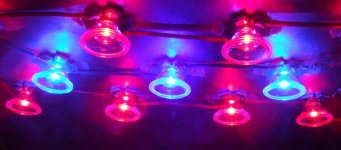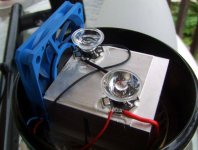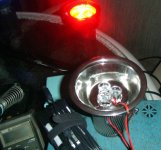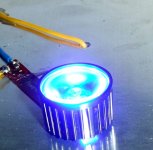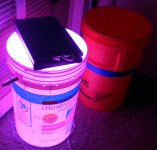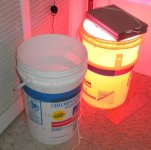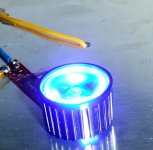-
Happy Birthday ICMag! Been 20 years since Gypsy Nirvana created the forum! We are celebrating with a 4/20 Giveaway and by launching a new Patreon tier called "420club". You can read more here.
-
Important notice: ICMag's T.O.U. has been updated. Please review it here. For your convenience, it is also available in the main forum menu, under 'Quick Links"!
You are using an out of date browser. It may not display this or other websites correctly.
You should upgrade or use an alternative browser.
You should upgrade or use an alternative browser.
Building New Panels - Sharing the Process
- Thread starter rrog
- Start date
The Sun has these frequencies all day so it's not like all day red is unusual. Having way too much red out of ratio with the rest of the spectrum would seem to be risky, though
Lots of red can cause stretch, but folks deal with it, apparently.
The real question is one of necessity, I think. Is there any improvement with added hours of red? My interest in this has been exclusively centered around resin and finishing the flower. The added perk of 13 hours of light is cool, but the primary goal is to have the flowers finish properly.
Previously I was simply looking for LED growers that used red and those that didn't. Those that did tended to be happy with their flowering and resin, I found. Very loose appraisal obviously, with very few people polled over 3 forums. What I didn't track carefully was if there was the issue of all-day-red vs. AM / PM short periods
Lots of red can cause stretch, but folks deal with it, apparently.
The real question is one of necessity, I think. Is there any improvement with added hours of red? My interest in this has been exclusively centered around resin and finishing the flower. The added perk of 13 hours of light is cool, but the primary goal is to have the flowers finish properly.
Previously I was simply looking for LED growers that used red and those that didn't. Those that did tended to be happy with their flowering and resin, I found. Very loose appraisal obviously, with very few people polled over 3 forums. What I didn't track carefully was if there was the issue of all-day-red vs. AM / PM short periods
The Sun has these frequencies all day so it's not like all day red is unusual. Having way too much red out of ratio with the rest of the spectrum would seem to be risky, though
Lots of red can cause stretch, but folks deal with it, apparently.
The real question is one of necessity, I think. Is there any improvement with added hours of red? My interest in this has been exclusively centered around resin and finishing the flower. The added perk of 13 hours of light is cool, but the primary goal is to have the flowers finish properly.
Previously I was simply looking for LED growers that used red and those that didn't. Those that did tended to be happy with their flowering and resin, I found. Very loose appraisal obviously, with very few people polled over 3 forums. What I didn't track carefully was if there was the issue of all-day-red vs. AM / PM short periods
Well, there's red, and then there's red.
730 NM. will cause stretch.
635 nm. will make buds.
652 nm. will make large, tight buds.
Mix n match to suit your needs.
Incandescent causes stretch because of the high far red to deep red ratio.
Keep reading, guys.
Google is your friend.
It gets incredibly complex, but just the basic facts will help you grow prize winners.

Aloha,
Weezard
Well, there's red, and then there's red
Right. We're talking about red, though.

speedyganga
New member
hi every one,
I love this thread, and I've to say you did some great job rrog! thanks for sharing.
I read a lot about led now, and I am almost ready to make my own panel.
by looking at this thread I wanted to ask you rrog, about your veg.
I want to make a pannel with a switch for veg/flo
It will mix white (XML2) and red (oslon SSL 80).
but then I was wondering about the spectrum.
The idea would be to have a white spectrum able to make a very good veg grow on its own and to put red leds on a dimmer in order to add more and more red during the flowering phase.
Hence I firstly need to find a veg spectrum that is also suitable for flowering by just adding some red.
I can't decide between the 2:2:1 ratio and the 1:1 (WW:NW) you did and also the 3:2:1 (WW:NW:CW).
My problem is quite simple: in the 2:2:1, I know it works on its own because of a journal from repuk. but he said he would put more red by adding 60w of red to his 150w withe leds. by looking at the spectrum, I agree with his observations, it seems to blue and there is a lack of red.
so I thought of 3:2:1 ratio which seems better to me.
and then I saw your panel with only NW and WW. By looking a the spectrum, it seems more polyvalent and outputs less blue. So I am wondering if this spectrum make a quick veg, because, it seems to be the best for the flowering coming after when I need only a few blue.
For now I think of going with NW and WW XML2 in veg with a 1:1 ratio
and for flowering something similar to this:
2NW:2WW:1 red XPE: 1 deep red oslon SSL 80.
White led will be driven at 1050mA and the red at 700mA
the dimmer on the red would unable me to govern correctly the stretch by modifying the blue/red ratio and the 660nm will interact with the 700nm wavelength emitted from the WW led
what do you think?
I love this thread, and I've to say you did some great job rrog! thanks for sharing.
I read a lot about led now, and I am almost ready to make my own panel.
by looking at this thread I wanted to ask you rrog, about your veg.
I want to make a pannel with a switch for veg/flo
It will mix white (XML2) and red (oslon SSL 80).
but then I was wondering about the spectrum.
The idea would be to have a white spectrum able to make a very good veg grow on its own and to put red leds on a dimmer in order to add more and more red during the flowering phase.
Hence I firstly need to find a veg spectrum that is also suitable for flowering by just adding some red.
I can't decide between the 2:2:1 ratio and the 1:1 (WW:NW) you did and also the 3:2:1 (WW:NW:CW).
My problem is quite simple: in the 2:2:1, I know it works on its own because of a journal from repuk. but he said he would put more red by adding 60w of red to his 150w withe leds. by looking at the spectrum, I agree with his observations, it seems to blue and there is a lack of red.
so I thought of 3:2:1 ratio which seems better to me.
and then I saw your panel with only NW and WW. By looking a the spectrum, it seems more polyvalent and outputs less blue. So I am wondering if this spectrum make a quick veg, because, it seems to be the best for the flowering coming after when I need only a few blue.
For now I think of going with NW and WW XML2 in veg with a 1:1 ratio
and for flowering something similar to this:
2NW:2WW:1 red XPE: 1 deep red oslon SSL 80.
White led will be driven at 1050mA and the red at 700mA
the dimmer on the red would unable me to govern correctly the stretch by modifying the blue/red ratio and the 660nm will interact with the 700nm wavelength emitted from the WW led
what do you think?
I'm back in internet land. Thanks for the inspiration, Wheeze-man. Nice assortment of reflectors and lenses. I'm interested in how much optical advantage I'd gain using these on the panel I just built. I had 50 Cree XM-L Whites running under conservative power putting out 300W, could I use these and get the same bang with only 45 XM-Ls? Is there a typical % adder?
I'm back in internet land. Thanks for the inspiration, Wheeze-man. Nice assortment of reflectors and lenses. I'm interested in how much optical advantage I'd gain using these on the panel I just built. I had 50 Cree XM-L Whites running under conservative power putting out 300W, could I use these and get the same bang with only 45 XM-Ls? Is there a typical % adder?
Yes there is.
Un-lensed leds have ~180 degree spread. (lambertian)
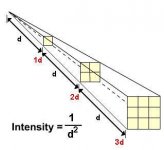
If you narrow the spread to 60 degrees you triple the intensity in that direction.
And that equals "penetration". (Grows bigger plants indoors.)
Minus ~15% loss in a cheap plastic lens, that's still a hell of a gain.
Math is fun, but testing tells the true tale.
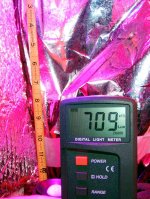
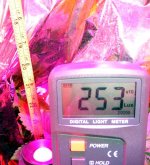
Throw on a lens and whip out your meter.
Aloha,
Weeze the pragmatic
Last edited:
The conical reflector, unless very near the emitter, has less gain than a lens and is mostly for my comfort.
Good emitters are hard on the eyes.
And yes, they are "glueons" .
Can't use them on my 15W. emitters because they would have to stay far above the crown to prevent light bleaching.
I just don't have that much headroom in the cabinet.
That, and they run too hot for a plastic lens.
They are tits with the 5 Watters though.
Google LED lenses.
Weeze
Good emitters are hard on the eyes.
And yes, they are "glueons" .
Can't use them on my 15W. emitters because they would have to stay far above the crown to prevent light bleaching.
I just don't have that much headroom in the cabinet.
That, and they run too hot for a plastic lens.
They are tits with the 5 Watters though.
Google LED lenses.
Weeze

